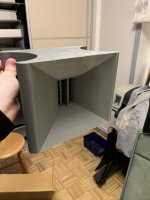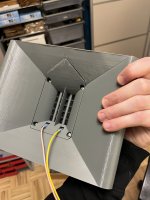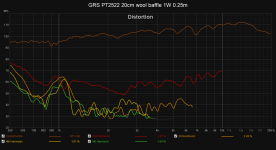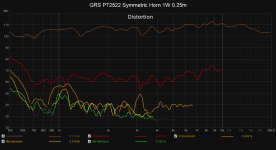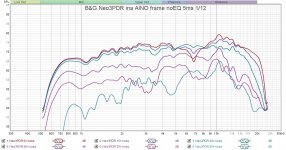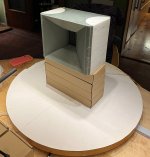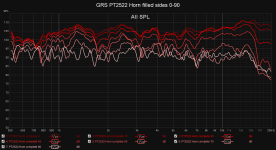Nola - nope! Typical marketing BS!
It is a regular dome tweeter that has closed backside. For midranges almost the same, motor/magnet is blocking practically all backside radiation.But I guess the midrange has some extra "air and transparency"...
It is a regular dome tweeter that has closed backside. For midranges almost the same, motor/magnet is blocking practically all backside radiation.But I guess the midrange has some extra "air and transparency"...
Juhazi, surely >some< sound comes out the back of this tweeter? There were earlier Alóns that were obviously not dipole tweeters...
I just got some interesting results with a GRS PT2522 in a 3d-printed symmetric horn:
The horn is 22 cm wide, 13 cm deep and 17 cm high.
The results are pretty amazing. A massive low frequency gain, distortion drops like a rock all while keeping a consistent dipole polar response. When compared to using a 20cm wool baffle it gains 10 dB sensitivity @ 1 khz while also reducing distortion figures. With such a horn It could probably be crossed at 1 khz or maybe even lower.
I'll have to test with some different horn profiles and see if I can make the response even better. This one is slightly exponential, I'll have to try oblate spheroid.
The horn is 22 cm wide, 13 cm deep and 17 cm high.
The results are pretty amazing. A massive low frequency gain, distortion drops like a rock all while keeping a consistent dipole polar response. When compared to using a 20cm wool baffle it gains 10 dB sensitivity @ 1 khz while also reducing distortion figures. With such a horn It could probably be crossed at 1 khz or maybe even lower.
I'll have to test with some different horn profiles and see if I can make the response even better. This one is slightly exponential, I'll have to try oblate spheroid.
Attachments
Yup, plotted equivalent 40 cm wide & 33 cm high baffle in Tolvan Edge and it predicts the dipole null at around the same frequency.
And yes, it isn't as flat as a nude driver but the low frequency gain and distortion reduction is attractive.
In my case I would use them in a CBT array of 18 drivers so my guess is that the dipole null would be about half as big as in this experiment altough the low frequency gain should also be less. Edge also predicts the null to be half as big although it doesn't have shading so not directly equivalent. But in my case if it results in the null being just 3 dB then it is something I can life with in trade of improved low frequency gain and reduced distortion.
Although of course I'll have to try without the horn too and see if I really need the horn to cross at 1 khz or if only nude drivers in an array is enough.
And yes, it isn't as flat as a nude driver but the low frequency gain and distortion reduction is attractive.
In my case I would use them in a CBT array of 18 drivers so my guess is that the dipole null would be about half as big as in this experiment altough the low frequency gain should also be less. Edge also predicts the null to be half as big although it doesn't have shading so not directly equivalent. But in my case if it results in the null being just 3 dB then it is something I can life with in trade of improved low frequency gain and reduced distortion.
Although of course I'll have to try without the horn too and see if I really need the horn to cross at 1 khz or if only nude drivers in an array is enough.
How abuout hemi- cylindrical side fill? High F ripples might come from too sharp edges (termination).
Another idea crossed my mind - how about forgetting to get dipole and just making long throats before horns start opening. Sort of two separate horns in opposing directions. Then summing/nulling happens below tweeter's passband. I think that doesn't do any harm unlike around 1-2kHz (but doing that with a planar is waste of resources)
This is actually Rudolf Finke's old thread with dipole tweeter tests (by the way nickname keyser is the father of D&D 8c speakers) best basic info in first pages!
https://www.diyaudio.com/community/threads/on-the-directivity-of-dipole-tweeters.161299/
Another idea crossed my mind - how about forgetting to get dipole and just making long throats before horns start opening. Sort of two separate horns in opposing directions. Then summing/nulling happens below tweeter's passband. I think that doesn't do any harm unlike around 1-2kHz (but doing that with a planar is waste of resources)
This is actually Rudolf Finke's old thread with dipole tweeter tests (by the way nickname keyser is the father of D&D 8c speakers) best basic info in first pages!
https://www.diyaudio.com/community/threads/on-the-directivity-of-dipole-tweeters.161299/
Last edited:
Yup, more rounded edges is on the TODO-list of things to try. I just fixed the CAD model such that instead of exponential-ish I can have an OSWG model where I can input throat roundover, angle and then edge roundover such that the edge roundover can be as big as I want it to be.
I also want to try to make basically the same design but with a meshed out waveguide where I apply some carpet wool to act as the solid waveguide. In my other tests it has worked great but should be fun to compare it directly to a solid waveguide of same shape.
And sure if the horn was big enough then the dipole peak could be pushed to below the pass band but that would be a HUGE horn. Like 50cm wide. to cross at ~ 1 khz. I would prefer if I can make it at most 24 cm wide.
Also worth mentioning is that I have also tried (but not in waveguides) with OC25SC65 and OC16SC04 back to back tweeters. They have really good polars but far less low frequency extension than then GRS PT2522, so considering my use case of many in a CBT array with low crossover I went with the PT2522.
I also want to try to make basically the same design but with a meshed out waveguide where I apply some carpet wool to act as the solid waveguide. In my other tests it has worked great but should be fun to compare it directly to a solid waveguide of same shape.
And sure if the horn was big enough then the dipole peak could be pushed to below the pass band but that would be a HUGE horn. Like 50cm wide. to cross at ~ 1 khz. I would prefer if I can make it at most 24 cm wide.
Also worth mentioning is that I have also tried (but not in waveguides) with OC25SC65 and OC16SC04 back to back tweeters. They have really good polars but far less low frequency extension than then GRS PT2522, so considering my use case of many in a CBT array with low crossover I went with the PT2522.
I have data!
It was a good suggestion to try bigger roundovers! I found a very interesting thread about such waveguides https://www.diyaudio.com/community/threads/curved-baffles-lead-to-narrower-beamwidth.339621/
It seems that while the big horns with little roundovers are very smooth on the top end it doesn't look as good on the low end. And even more interesting is that the less rounded waveguides have more narrow dispersion than the coverage angle.
As far as I can see the pretty shallow 90 degree angle with the huge 10 cm roundover has the most uniform response over the whole frequency range. The mesh wool waveguide is just bad. I think it would perform better without the vertical vanes since I have done similar enough previous tests and then it has worked well.
I also measured with two waveguide slices on top of another and it does smooth everything out a bit. The dipole null is still there but even with 2 it gets smaller. With even more drivers I believe it would be small enough to accept in exchange for the improved low frequency extension and reduced distortion. Nice for me since my intended application is a curved CBT array with a lot of drivers where I want to cross as low as possible to avoid lobing.
Next tests will probably be to scale up the big shallow 10 cm roundover to 2 or 4 tweeter heights with optional vertical vanes so I can try with and without. I might also do a mesh wool test of the same bigger waveguide but on the mesh I'll probably skip the vanes completely.
It was a good suggestion to try bigger roundovers! I found a very interesting thread about such waveguides https://www.diyaudio.com/community/threads/curved-baffles-lead-to-narrower-beamwidth.339621/
It seems that while the big horns with little roundovers are very smooth on the top end it doesn't look as good on the low end. And even more interesting is that the less rounded waveguides have more narrow dispersion than the coverage angle.
As far as I can see the pretty shallow 90 degree angle with the huge 10 cm roundover has the most uniform response over the whole frequency range. The mesh wool waveguide is just bad. I think it would perform better without the vertical vanes since I have done similar enough previous tests and then it has worked well.
I also measured with two waveguide slices on top of another and it does smooth everything out a bit. The dipole null is still there but even with 2 it gets smaller. With even more drivers I believe it would be small enough to accept in exchange for the improved low frequency extension and reduced distortion. Nice for me since my intended application is a curved CBT array with a lot of drivers where I want to cross as low as possible to avoid lobing.
Next tests will probably be to scale up the big shallow 10 cm roundover to 2 or 4 tweeter heights with optional vertical vanes so I can try with and without. I might also do a mesh wool test of the same bigger waveguide but on the mesh I'll probably skip the vanes completely.
Attachments
-
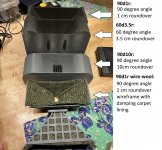 dipole-tweeter-waveguide-tests.jpg720.3 KB · Views: 142
dipole-tweeter-waveguide-tests.jpg720.3 KB · Views: 142 -
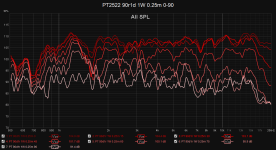 PT2522 90r1d 1W 0.25m 0-90.png75.4 KB · Views: 125
PT2522 90r1d 1W 0.25m 0-90.png75.4 KB · Views: 125 -
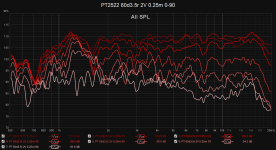 PT2522 60d3.5r 2V 0.25m 0-90.png75 KB · Views: 123
PT2522 60d3.5r 2V 0.25m 0-90.png75 KB · Views: 123 -
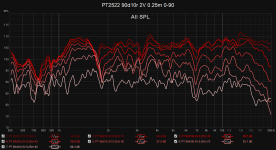 PT2522 90d10r 2V 0.25m 0-90.png72.6 KB · Views: 110
PT2522 90d10r 2V 0.25m 0-90.png72.6 KB · Views: 110 -
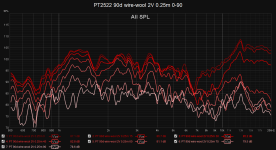 PT2522 90d wire-wool 2V 0.25m 0-90.png76.9 KB · Views: 127
PT2522 90d wire-wool 2V 0.25m 0-90.png76.9 KB · Views: 127 -
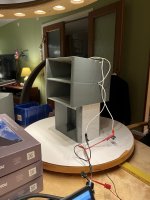 IMG_0230.JPG375.6 KB · Views: 138
IMG_0230.JPG375.6 KB · Views: 138 -
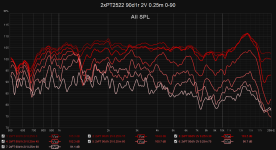 2xPT2522 90d1r 2V 0.25m 0-90.png70 KB · Views: 130
2xPT2522 90d1r 2V 0.25m 0-90.png70 KB · Views: 130
Last edited:
- Home
- Loudspeakers
- Multi-Way
- On the directivity of dipole tweeters

